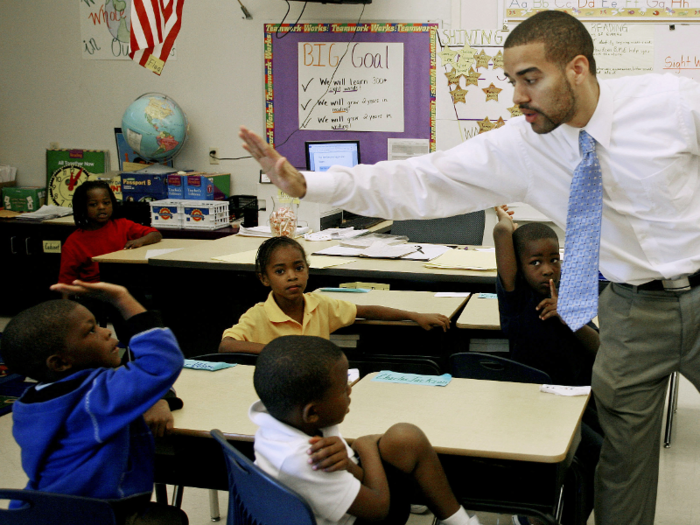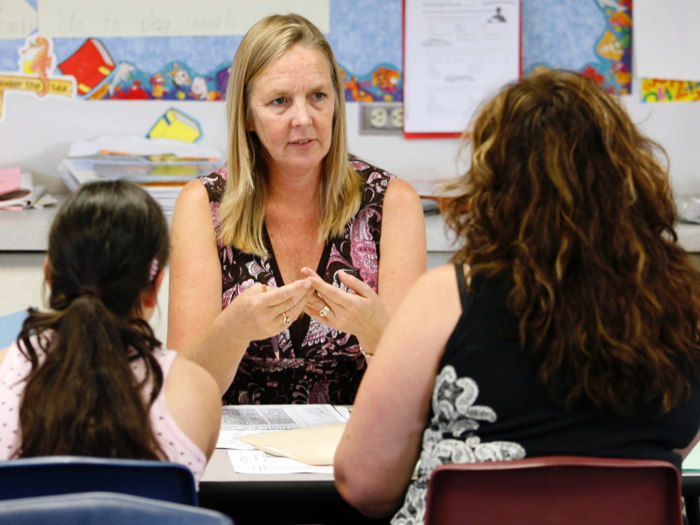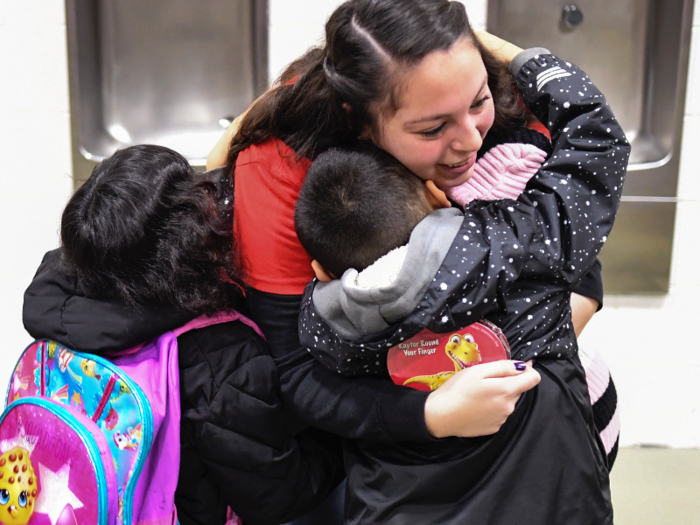- Home
- slideshows
- miscellaneous
- 7 things you might not realize teachers have to do after the school day ends
7 things you might not realize teachers have to do after the school day ends
Teachers can spend hours grading their students' homework and tests.

Teacher prep periods can't always be used for prep.

Most schools give teachers what is called a prep period during the school day. This is a period of time, often around 45 minutes, that teachers are meant to use to prepare for their lessons, grade, and do other non-teaching tasks during the work day.
However, teachers might not always be able to use this period for its intended purpose.
One reason why is a simple lack of resources, Tori Van Horn, a second grade special education teacher from Pennsylvania, told Business Insider.
"There are other teachers that have prep at the same time as me, so sometimes making copies can be tough," she said. "I have my own laminator at home because my school's has been broken forever."
A bigger issue, though, is that her prep period doesn't allow her enough time to really focus.
"I'm interpreting a lot of data and coming up with specific goals for my students to work towards," she said. "I find it difficult to jump into a big legal document for only 40 minutes at a time. I need to sit and focus to make sure I'm doing my best work."
And other times, teachers simply need a break.
"Sometimes I just want to sit during my lunch," Julia Van Ness said. "After teaching for four hours straight and then covering lunch duty, I know I need to take a few minutes and just sit there to let myself recharge. I would rather finish something at home than let myself burn out by 3 o'clock."
Many teachers spend time on other school-related commitments like coaching sports teams, advising student clubs, or attending teacher meetings.

Even though almost all teachers come in to school early and leave late, you can't assume that all of that extra time is going to matters directly related to teaching.
"Teachers face numerous demands that aren't listed in our contracts," Julia Van Ness said. "Student situations, meetings, creating schedules or flyers for school events, and basically handling the day's chaos can leave you feeling like you got nothing done that day. Sometimes that's just how it goes."
Aside from attending departmental and training meetings, many schools have requirements that teachers help with a certain number of school-sponsored activities per year. This can mean chaperoning dances, monitoring lunch periods, or being on bus duty.
Other teachers with special interests may go above and beyond, becoming club advisers, theater directors, or sports coaches when the school day lets out. Music teachers often spend a lot of time outside of school hours on practices or concerts for student groups. Veteran teachers may take extra time to mentor new ones.
Planning lessons can take several hours a week.

For many teachers, planning lessons is one of the most time-consuming aspects of the job.
"I spend most time planning and prepping lessons for each day," Elizabeth Fela, a sixth-grade teacher from Illinois. "Planning for four different lessons a day is a lot of work. I make a lot of instructional materials myself. Not everything is provided to us, so I have to make assignments and games and all that on my own time."
Additionally, for some teachers, lesson planning doesn't always look like you might expect it to. Mary Saydah, who teaches special education in New Jersey, explained how her lesson planning can often involve a few extra elements.
"Most of my students are significantly visually impaired or blind, so for every lesson, I need an element they can explore either through touch or smell that relates to the lesson," Saydah said. "This can mean making a small mop out of popsicle sticks and yarn to represent an object in the story or having to make individualized worksheets for each student that I have to add numbers onto with puffy paint so they can explore it.
"It also means going to the store to buy materials a lot of the time," she continued. "When I lesson plan, I have to keep a running list of everything I need to make and buy for the following week. While I do get reimbursed, it is time-consuming to go to the store and find what I need"
Sometimes students need more individualized help, which means more time and paperwork customizing lesson plans.

For many teachers, especially teachers whose students have IEPs, or Individualized Education Plans, lesson plans need to be tailored specifically to fit each student's needs.
"My students are below grade level in different areas like reading and math," Stephanie Kay, a middle school special education teacher from Pennsylvania, told Business Insider. "I have to individualize different aspects of the curriculum so they can access it to the best of their ability. That involves writing each document (about 30 pages), making multiple attempts to call the parent to schedule the meeting, holding the meetings, and waiting for signed paperwork from parents."
Teaching students with IEPs also involves a lot more paperwork than other teachers normally see.
"I have to write IEPs for my caseload, give input for other students' IEPs, figure out what skills or concepts my kids need to be addressed in," Kay said. "I also have to find, print, and grade progress monitoring based on goals in their IEPs. I teach about 40 kids and have to monitor 27 goals."
Kay also mentioned that she holds IEP meetings with her students' parents on her own time.
Communicating with parents and students is another after-hours responsibility.

Many teachers spend time at home corresponding with teachers and students.
"For any one assignment, you could have a student who can't login to the website, forgot their paper at school, had sports practice all night and is asking you for extra time, doesn't understand the directions, and other sorts of excuses," Van Ness said.
"Responding to student and parent concerns can end up taking around 20 minutes depending on the day. Parent emails take me a while to write because often I reread them several times to ensure I communicated the information clearly in a friendly tone."
"It's something we spend a lot of time thinking about," Van Ness said.
And depending on the circumstances of their students, some teachers act as their caregivers, offering students emotional support and addressing behavioral issues.

When it comes down to it, teachers aren't just there to help students academically. They're also there to help their students grow as people.
Aside from teaching lessons, many teachers find that it is also their job to be a caregiver for their students, addressing behavioral issues, offering emotional support, and giving advice or guidance to students who come to them seeking it.
For some teachers, like Fela, this part of the job can be more time consuming than it is for others.
"My demographic presents a lot of social-emotional issues with students. Things like their parents being on drugs, being removed from their homes, not having a parent there when they get home, or sometimes not even having food at home, are problems my students deal with daily."
"We expect students to come to school ready to learn, when in reality they come to school to be safe and fed."
Fela explained that this part of the job isn't a separate responsibility — it's integral to helping students absorb the information they're being taught.
"Kids aren't ready to learn unless they have their basic needs met first."
Popular Right Now
Popular Keywords
Advertisement